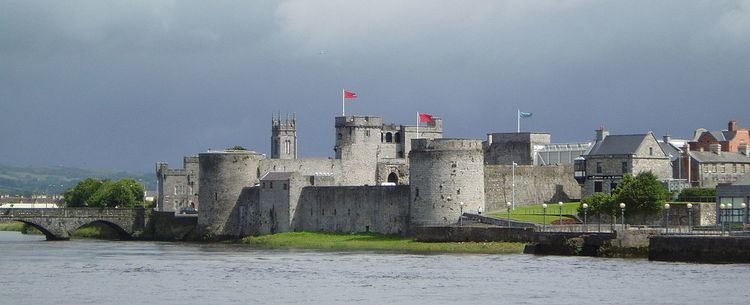 | ||
The Chief Justice of Munster was the senior of the two judges who assisted the Lord President of Munster in judicial matters. Despite the judge's title of Chief Justice, full judicial authority was actually vested in the Lord President, who "had power to hear and determine at his discretion all manner of complaints in any part of the province of Munster", and also had powers of oyer and terminer and gaol delivery.
Contents
Role of the Chief Justice of Munster
The hearing of judicial business in the province of Munster was delegated by the Lord President to the Chief Justice and the second justice, who were members of the President's council and always travelled with him on circuit. In the court's earlier years, it seems that there was no central judicial seat: the court could be convened wherever the President thought it necessary. Due to the chronic disturbances in Elizabethan Munster the circuit could be a hazardous one: there was a serious riot in Tralee in 1579 in which several officials were reported to have been killed. In 1601-2, during the crisis caused by the Battle of Kinsale, the Lord President's Court temporarily assumed the powers of the courts of common law. In 1620 one of the judges of the Court recorded that "when the President goeth forth, he is attended in military form, when he rideth, by a troop of horse (cavalry), when he walketh by a company of foot (infantry) with pikes and muskets".
The width of the powers given to the President's court led to clashes with the long-established courts, especially the Court of Chancery (Ireland). In 1622 a sharp instruction was issued to the Court of Munster, and its fellow court in Connacht, not to "intermeddle" with cases which were properly the business of another court.
By 1620, according to Luke Gernon, second justice of Munster, the Court had established a permanent seat in Limerick, where it held its sessions in King John's Castle. In his interesting manuscript, A Discourse of Ireland 1620, Gernon states that the Court was modeled on the Council of Wales and the Marches, with "a President, two justices and a council. We sit in council at a table".
The office of Chief Justice of Munster was an onerous one, and it was generally considered inadvisable to combine it with any other senior judicial position: William Saxey aroused much indignation in 1599 when he refused to resign as Chief Justice on being appointed to the Court of King's Bench (Ireland), especially as he apparently never sat in the latter Court. On the other hand, it was understood that the office holder could expect to be promoted in due course to one of the courts of common law, and possibly become its Chief Justice, as James Dowdall, Sir Nicholas Walsh and Lord Sarsfield did.
An exception to the ban on holding two offices at once seems to have been made for Gerald Comerford, who was appointed both Chief Justice of Munster and a Baron of the Court of Exchequer (Ireland) shortly before his death in 1604: this was probably his reward for his 20 years of loyal service to the Crown, his lack of a proper reward being a subject about which he had complained frequently over the years. There was apparently no objection to the Chief Justice holding a purely local judicial office at the same time: Henry Gosnold, through much of his long career, was also the Admiralty judge for Munster. This was at the time the only local section of the Irish Admiralty Court: the judge in Munster was a deputy to the Lord Chancellor of Ireland, acting in his role as the Irish Admiralty judge.
Civil War and Restoration
During the disturbed period following the English Civil War the office of Chief Justice seems to have simply lapsed, although Henry Gosnold, the then holder of the office, who had been appointed in 1624, reached a great age and may still have been alive in 1658. It was briefly held by the regicide John Cook, who in 1655 abolished the provincial court and replaced it with a number of county courts. William Halsey, the second justice of Munster, served under the Cromwellian regime in a number of capacities, including his old office of second justice. The office was revived at the Restoration: perhaps surprisingly the new Chief Justice was Halsey himself, despite his services to Oliver Cromwell: this was said to be a tribute to the high regard in which he was held, although his critics were not slow to accuse him of disloyalty. He was to be the last holder of the office, which was abolished in 1672.
List of Chief Justices of Munster 1569-1672
Interregnum
Office abolished 1672
Second Justices of Munster
Incomplete list
